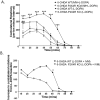Role of purinergic P2X4 receptors in regulating striatal dopamine homeostasis and dependent behaviors
- PMID: 27402173
- PMCID: PMC5037001
- DOI: 10.1111/jnc.13734
Role of purinergic P2X4 receptors in regulating striatal dopamine homeostasis and dependent behaviors
Abstract
Purinergic P2X4 receptors (P2X4Rs) belong to the P2X superfamily of ion channels regulated by ATP. We recently demonstrated that P2X4R knockout (KO) mice exhibited deficits in sensorimotor gating, social interaction, and ethanol drinking behavior. Dopamine (DA) dysfunction may underlie these behavioral changes, but there is no direct evidence for P2X4Rs' role in DA neurotransmission. To test this hypothesis, we measured markers of DA function and dependent behaviors in P2X4R KO mice. P2X4R KO mice exhibited altered density of pre-synaptic markers including tyrosine hydroxylase, dopamine transporter; post-synaptic markers including dopamine receptors and phosphorylation of downstream targets including dopamine and cyclic-AMP regulated phosphoprotein of 32 kDa and cyclic-AMP-response element binding protein in different parts of the striatum. Ivermectin, an allosteric modulator of P2X4Rs, significantly affected dopamine and cyclic AMP regulated phosphoprotein of 32 kDa and extracellular regulated kinase1/2 phosphorylation in the striatum. Sensorimotor gating deficits in P2X4R KO mice were rescued by DA antagonists. Using the 6-hydroxydopamine model of DA depletion, P2X4R KO mice exhibited an attenuated levodopa (L-DOPA)-induced motor behavior, whereas ivermectin enhanced this behavior. Collectively, these findings identified an important role for P2X4Rs in maintaining DA homeostasis and illustrate how this association is important for CNS functions including motor control and sensorimotor gating. We propose that P2X4 receptors (P2X4Rs) regulate dopamine (DA) homeostasis and associated behaviors. Pre-synaptic and post-synaptic DA markers were significantly altered in the dorsal and ventral striatum of P2X4R KO mice, implicating altered DA neurotransmission. Sensorimotor gating deficits in P2X4R KO mice were rescued by DA antagonists. Ivermectin (IVM), a positive modulator of P2X4Rs, enhanced levodopa (L-DOPA)-induced motor behavior. These studies highlight potential interactions between P2X4Rs and DA system.
Keywords: 6-OHDA; Ivermectin; P2X4 receptors; Parkinson's disease; dopamine receptors; schizophrenia.
© 2016 International Society for Neurochemistry.
Conflict of interest statement
Authors have no other conflict of interest to declare.
Figures






Similar articles
-
Dopamine Receptor Blockade Attenuates Purinergic P2X4 Receptor-Mediated Prepulse Inhibition Deficits and Underlying Molecular Mechanisms.Front Cell Neurosci. 2019 Jul 23;13:331. doi: 10.3389/fncel.2019.00331. eCollection 2019. Front Cell Neurosci. 2019. PMID: 31396053 Free PMC article.
-
Reduced expression of purinergic P2X4 receptors increases voluntary ethanol intake in C57BL/6J mice.Alcohol. 2018 May;68:63-70. doi: 10.1016/j.alcohol.2017.09.004. Epub 2017 Sep 30. Alcohol. 2018. PMID: 29477921 Free PMC article.
-
Sociocommunicative and sensorimotor impairments in male P2X4-deficient mice.Neuropsychopharmacology. 2013 Sep;38(10):1993-2002. doi: 10.1038/npp.2013.98. Epub 2013 Apr 19. Neuropsychopharmacology. 2013. PMID: 23604007 Free PMC article.
-
P2X4 receptors (P2X4Rs) represent a novel target for the development of drugs to prevent and/or treat alcohol use disorders.Front Neurosci. 2014 Jun 24;8:176. doi: 10.3389/fnins.2014.00176. eCollection 2014. Front Neurosci. 2014. PMID: 25009459 Free PMC article. Review.
-
Preclinical evaluation of avermectins as novel therapeutic agents for alcohol use disorders.Psychopharmacology (Berl). 2018 Jun;235(6):1697-1709. doi: 10.1007/s00213-018-4869-9. Epub 2018 Mar 2. Psychopharmacology (Berl). 2018. PMID: 29500584 Free PMC article. Review.
Cited by
-
Avermectin Derivatives, Pharmacokinetics, Therapeutic and Toxic Dosages, Mechanism of Action, and Their Biological Effects.Pharmaceuticals (Basel). 2020 Aug 17;13(8):196. doi: 10.3390/ph13080196. Pharmaceuticals (Basel). 2020. PMID: 32824399 Free PMC article. Review.
-
Relationship between P2XR4 Gene Variants and the Risk of Schizophrenia in South-East of Iran: A Preliminary Case-Control Study and in Silico Analysis.Iran J Public Health. 2021 May;50(5):978-989. doi: 10.18502/ijph.v50i5.6115. Iran J Public Health. 2021. PMID: 34183956 Free PMC article.
-
Modulation of P2X4 receptor activity by ivermectin and 5-BDBD has no effect on the development of ARPKD in PCK rats.Physiol Rep. 2022 Nov;10(21):e15510. doi: 10.14814/phy2.15510. Physiol Rep. 2022. PMID: 36353932 Free PMC article.
-
Purinergic Signalling: Therapeutic Developments.Front Pharmacol. 2017 Sep 25;8:661. doi: 10.3389/fphar.2017.00661. eCollection 2017. Front Pharmacol. 2017. PMID: 28993732 Free PMC article. Review.
-
P2X4: A fast and sensitive purinergic receptor.Biomed J. 2017 Oct;40(5):245-256. doi: 10.1016/j.bj.2017.06.010. Epub 2017 Nov 10. Biomed J. 2017. PMID: 29179879 Free PMC article. Review.
References
-
- Abduljawad KA, Langley RW, Bradshaw CM, Szabadi E. Effects of bromocriptine and haloperidol on prepulse inhibition of the acoustic startle response in man. J Psychopharmacol. 1998;12:239–245. - PubMed
-
- Andries M, Van Damme P, Robberecht W, Van Den Bosch L. Ivermectin inhibits AMPA receptor-mediated excitotoxicity in cultured motor neurons and extends the life span of a transgenic mouse model of amyotrophic lateral sclerosis. Neurobiol Dis. 2007;25:8–16. - PubMed
-
- Bailer U, Leisch F, Meszaros K, et al. Genome scan for susceptibility loci for schizophrenia. Neuropsychobiology. 2000;42:175–182. - PubMed
Publication types
MeSH terms
Substances
Grants and funding
LinkOut - more resources
Full Text Sources
Other Literature Sources
Molecular Biology Databases
Research Materials

